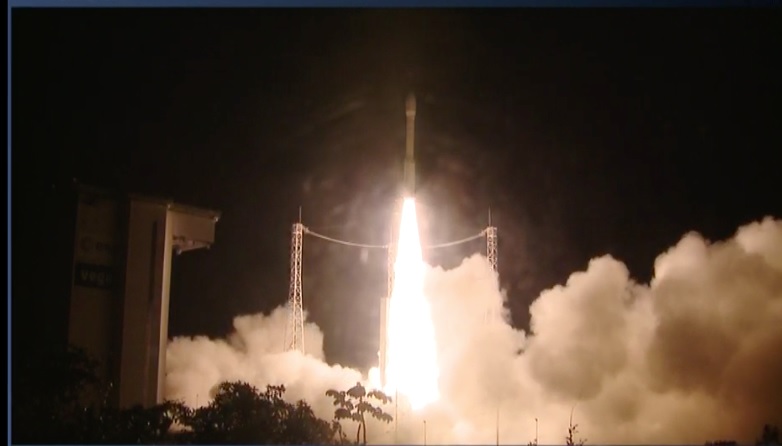Arianespace, Avio launch 10th Vega rocket, orbit two Israeli-made satellites
WASHINGTON — Arianespace's smallest rocket launched two remote sensing satellites co-produced by Israeli and European teams on an Aug. 1 night mission from the European spaceport in Kourou, French Guiana.
Built by the Italian provider Avio with support from the European Space Agency, Vega now has 10 missions completed since debuting in 2012, launching successfully each time — a feat for the harrowing early days of any launch system where failures are all but expected.
Vega lifted off at 9:58 p.m. Eastern from the Guiana Space Centre's Vega Launch Complex on a mission lasting slightly over one hour and 37 minutes. The launcher deployed both satellites — the 368-kilogram Optsat-3000 and the 264-kilogram Venμs, or Vegetation and Environment monitoring on a New Micro Satellite — into sun-synchronous orbits. [Photos: Meet Vega, Europe's New Rocket]

Avio CEO Giulio Ranzo told SpaceNews Aug. 1 that Vega owes much of its success to simplicity in design.
"Vega was conceived with a simple architecture based on solid propulsion, which is inherently simpler than liquid propulsion as it is made of much fewer parts," he said, adding that Avio has been building solid rocket motors for more than five decades and has the full manufacturing process vertically integrated. "This factor is certainly responsible for a good part of Vega's reliability."
The European Space Agency, spurred by the Italian Space Agency, approved the development of Vega in 2003. Arianespace took commercial responsibility for Vega launches in 2015 after six successful flights.
Three of Vega's stages, the P80 first stage, Zefiro-23 second stage and Zefiro-9 third stage, all use solid propulsion. Ukrainian rocketry company Yuzhnoye provides the fourth and final stage, the Attitude and Vernier Upper Module, or AVUM, a bipropellant liquid propulsion engine. Ranzo said this upper stage "is also relatively simple" despite being a re-ignitable liquid propulsion system. He said AVUM uses an avionics suite derived from the Ariane 5, Arianespace's main heavy lift launcher that in June completed its 80th consecutive successful mission.
Get the Space.com Newsletter
Breaking space news, the latest updates on rocket launches, skywatching events and more!
"The collaboration methodology we have put in place with Arianespace and ESA throughout the last few decades is particularly effective in early detection of potential anomalies," said Ranzo. "When you put all these aspects together, this is why Vega is so reliable."
Vega's design has not changed since the rocket was introduced, Ranzo said, though some components have been optimised. ESA said Aug. 2 that Vega used a lighter payload fairing from Ruag Space Switzerland and ELV, a joint company between Avio and the Italian Space Agency, during its most recent mission.
Arianespace's Aug. 1 launch, the company's eighth for the year, placed the Italian Ministry of Defense's Optsat-3000 into low-Earth orbit about 42 minutes after liftoff. The Israel Space Agency and French space agency CNES's Venμs satellite separated 49 minutes later.
Optsat-3000 is a high resolution optical satellite that Israel Aerospace Industries, or IAI, built along with the ground segment through an Italian-Israeli inter-governmental agreement. The Leonardo-Thales joint venture Telespazio of Rome was the prime contractor for the mission, and German satellite manufacturer OHB Systems' Italian division OHB Italia handled launch services and associated engineering support. Optsat-3000 is designed to last more than seven years from its 450-kilometer orbit, and will complement the second-generation Cosmo-SkyMed Italian radar satellites.
The Venμs satellite is designed to capture 760-square kilometer multispectral photos in 12 wavelengths for vegetation monitoring. The satellite also carries a new Hall effect electric propulsion system from Israeli manufacturer Rafael Advanced Defense Systems. Venμs has a chemical propulsion system as backup. The spacecraft has a design life of four and a half years.
Europe's next generation iteration of Vega, called Vega-C, is scheduled for a first flight in 2019. Airbus in June procured two Vega C launches to orbit four Earth observation satellites two at a time. Vega C is designed to launch 2,300 kilograms to sun-synchronous orbit, up from Vega's 1,500 kilograms.
This story was provided by SpaceNews, dedicated to covering all aspects of the space industry.
Join our Space Forums to keep talking space on the latest missions, night sky and more! And if you have a news tip, correction or comment, let us know at: community@space.com.
Caleb Henry is a senior analyst for Quilty Analytics and a former staff writer for the space industry publication SpaceNews. From 2016 to 2020, Caleb covered the global satellite industry for SpaceNews, chronicling everything from launches, spacecraft manufacturing and ground infrastructure. Caleb's work has also appeared in NewSpace Global and Access Intelligence. He earned a bachelor's degree in political science with a minor in astronomy from Grove City College.










